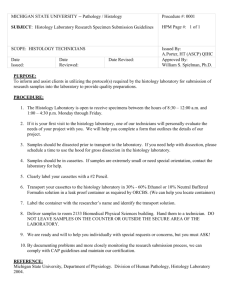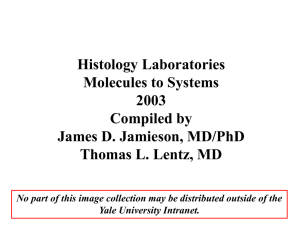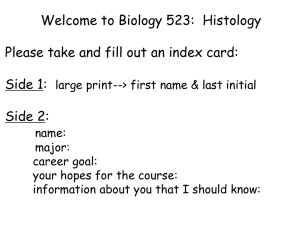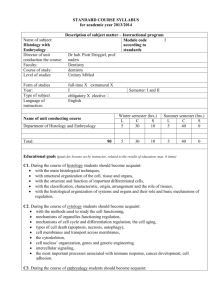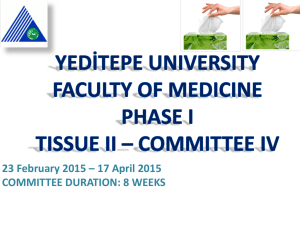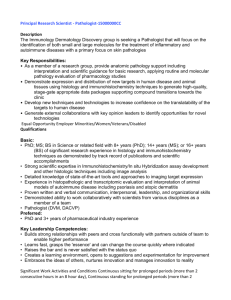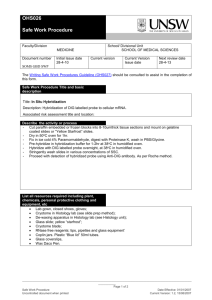Histology Syllabus 2015 - IU School of Medicine
advertisement
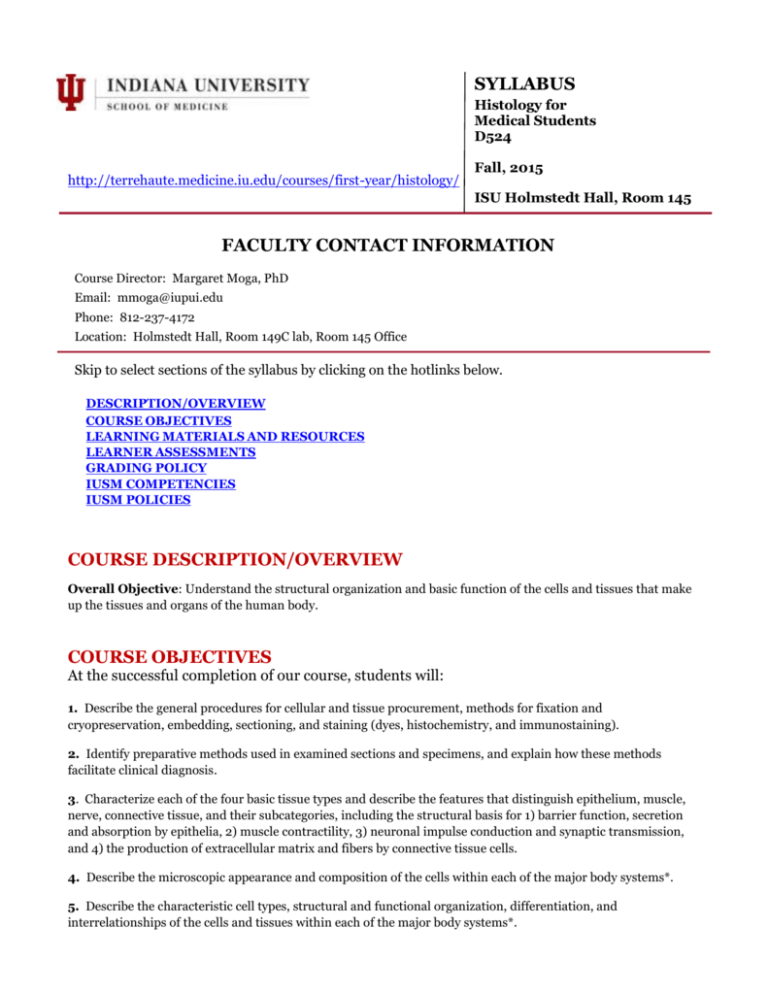
SYLLABUS Histology for Medical Students D524 http://terrehaute.medicine.iu.edu/courses/first-year/histology/ Fall, 2015 ISU Holmstedt Hall, Room 145 FACULTY CONTACT INFORMATION Course Director: Margaret Moga, PhD Email: mmoga@iupui.edu Phone: 812-237-4172 Location: Holmstedt Hall, Room 149C lab, Room 145 Office Skip to select sections of the syllabus by clicking on the hotlinks below. DESCRIPTION/OVERVIEW COURSE OBJECTIVES LEARNING MATERIALS AND RESOURCES LEARNER ASSESSMENTS GRADING POLICY IUSM COMPETENCIES IUSM POLICIES COURSE DESCRIPTION/OVERVIEW Overall Objective: Understand the structural organization and basic function of the cells and tissues that make up the tissues and organs of the human body. COURSE OBJECTIVES At the successful completion of our course, students will: 1. Describe the general procedures for cellular and tissue procurement, methods for fixation and cryopreservation, embedding, sectioning, and staining (dyes, histochemistry, and immunostaining). 2. Identify preparative methods used in examined sections and specimens, and explain how these methods facilitate clinical diagnosis. 3. Characterize each of the four basic tissue types and describe the features that distinguish epithelium, muscle, nerve, connective tissue, and their subcategories, including the structural basis for 1) barrier function, secretion and absorption by epithelia, 2) muscle contractility, 3) neuronal impulse conduction and synaptic transmission, and 4) the production of extracellular matrix and fibers by connective tissue cells. 4. Describe the microscopic appearance and composition of the cells within each of the major body systems*. 5. Describe the characteristic cell types, structural and functional organization, differentiation, and interrelationships of the cells and tissues within each of the major body systems*. 6. Demonstrate effective communication and professionalism skills while working in teams to analyze and present laboratory specimens and case-based materials. 7. Identify gaps in personal knowledge of histology and utilize this information to guide and remedy these deficiencies. *Organ systems include the cardiovascular, digestive, endocrine, immune, integumentary, lymphatic, muscular, nervous, renal, reproductive, respiratory, and skeletal systems. LEARNING MATERIALS AND RESOURCES Textbook and recommended instructional materials: The recommended textbook, Junqueira’s Basic Histology: Text and Atlas, 13th edition (written by Dr. Anthony Mescher, IUSM-Bloomington), is free and available online via Access Medicine through the IUSM Ruth Lilly Library main webpage. The recommended review book, Histology and Cell Biology: Examination and Board Review, Fifth Edition (LANGE Basic Science), is free and available online via Access Medicine through the IUSM Ruth Lilly Library main webpage. Flashcards are helpful for some students. Several different sets are available for purchase online (e.g., LANGE, Netter’s, Cui). One example: Mescher (2011) Lange Junqueira's High Yield Histology Flash Cards (LANGE FlashCards) Lecture powerpoints, lab handouts and previous year quizzes are available online through IU Canvas. Virtual microscope slides used in the course are available through an IU website. LEARNER ASSESSMENTS Course grade = Daily quizzes, Histology component of 4 combined exams, and a final exam Histology Quizzes (12% of course grade) The Histology Quizzes will be composed of Individual Quizzes (6% of course grade) and Team Quizzes (6% of course grade). Each class period will start with a Histology Quiz on material covered in the previous class period. Students will take the Individual Quiz by themselves, and then, with their team, they will discuss the questions and answers, and then fill out a Team Quiz. Quizzes will be 10 multiple-choice questions, with 3 – 4 images. Combined Examinations (68% of course grade) Four combined examinations will be given in the Fall semester, combining questions from Histology, Gross Anatomy, Biochemistry, Immunology and ICM1. The Histology component of each combined examination will consist of a written portion (administered in the morning) and a laboratory portion (administered in the afternoon). The written examination (multiple choice questions) will be based on the course objectives, study questions presented in lectures, and related material in the course textbook, lectures and labs. The laboratory examination will be multiple-choice and will consist of Powerpoint images from a variety of sources, including course lectures, labs, textbook, and flashcards. If a student fails the Histology component of a combined exam, the course director will contact the student inviting the student to meet to discuss their performance and to implement study strategies to avoid recurrence on a subsequent exam. Students are advised that they should speak with their course director and/or center director regarding assistance that may be locally available. In addition to IUSM-TH faculty, students may also want to contact Dr. Patricia Wade, Learning Specialist, IUSM Medical Student Affairs for assistance. Her contact information is: patwade@iupui.edu. Final exam (Statewide Examination, 20% of course grade) The Final exam will be administered statewide. This examination (20% of course grade) is a customized subject examination purchased from and graded by the National Board of Medical Examiners (NBME). This exam will be administered at the end of the course. It serves as a comparison of student Histology knowledge across the IUSM statewide centers. The exam is 100 multiple choice questions emphasizing structure-function correlations in histology. It contains questions on basic tissues and organ systems. It includes ~35 micrographs (LM, TEM, SEM). The exam has very little cell biology. There are no questions on the eye or ear. Exam dates are posted on the course calendar and syllabus on IU Canvas. Quiz and exam results will be posted on IU Canvas. GRADING POLICY Honors: 92% and above High Pass: 84 - 91% Pass: 70 - 83% Fail: below 70% IUSM COMPETENCIES and ASSESSMENT The Interpersonal Communication Skills (ICS) competency will be formally assessed in Histology. The laboratory portion of the Histology course will be presented by student teams in front of the class, with each team presenting virtual or glass microscope slides to the class during 2 or 3 labs. A short Likert scale may be used to assess the communication skills of each student during their laboratory presentation. IUSM POLICIES Student Handbook Academic Dishonesty Grade and Competency Appeal Process Attendance, Exam Postponement, Dress Code IUSM Core Values and Guiding Principles
